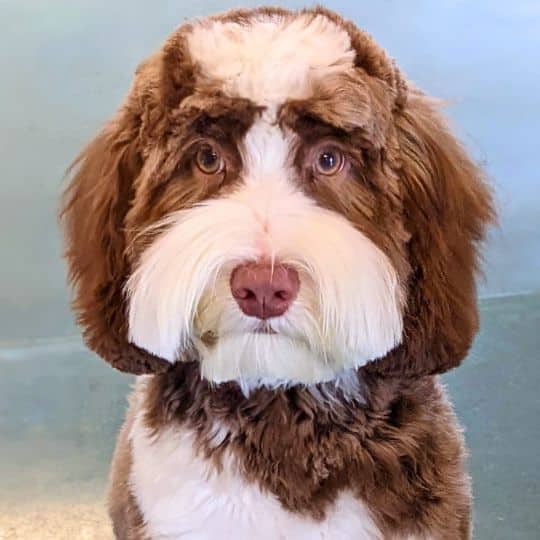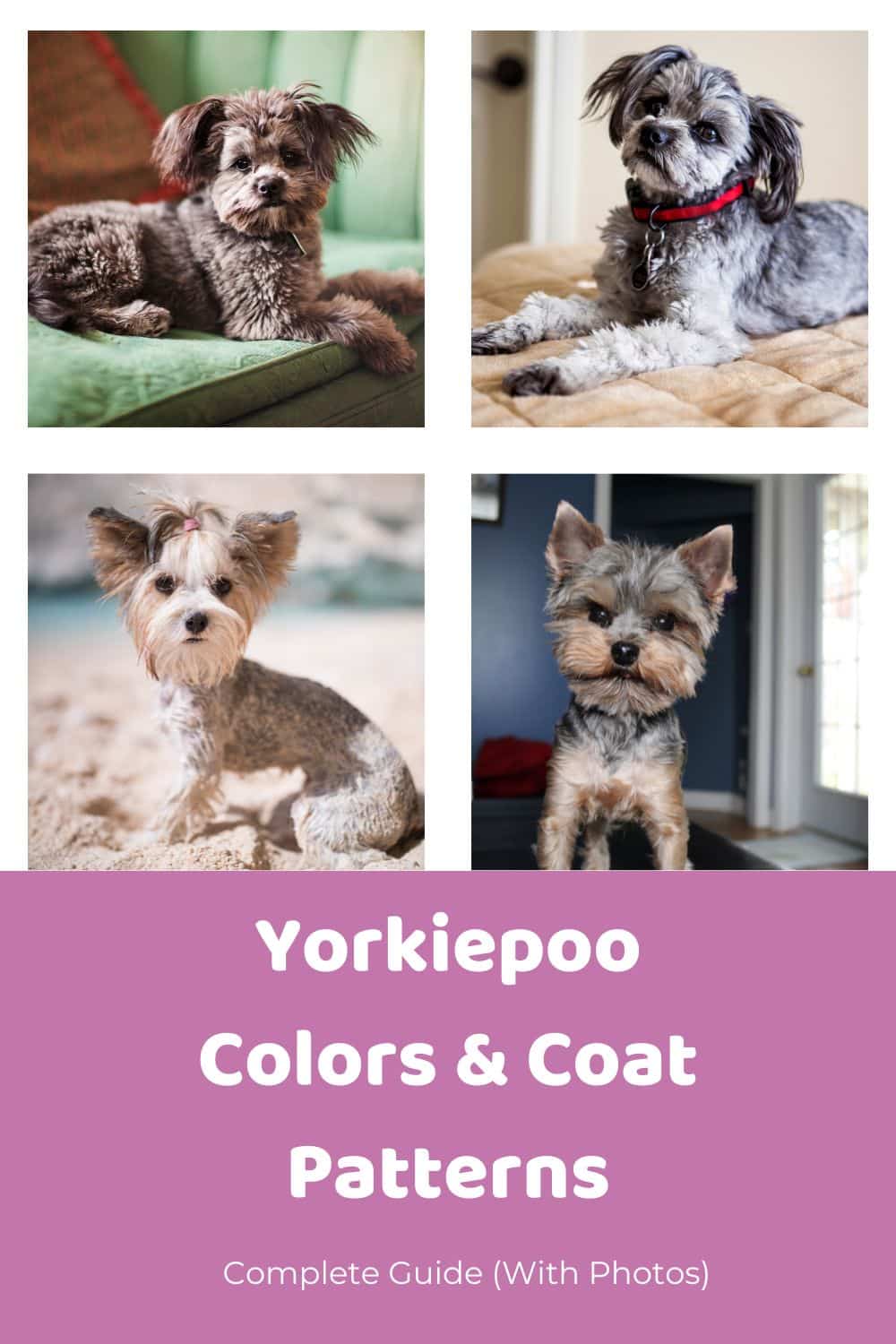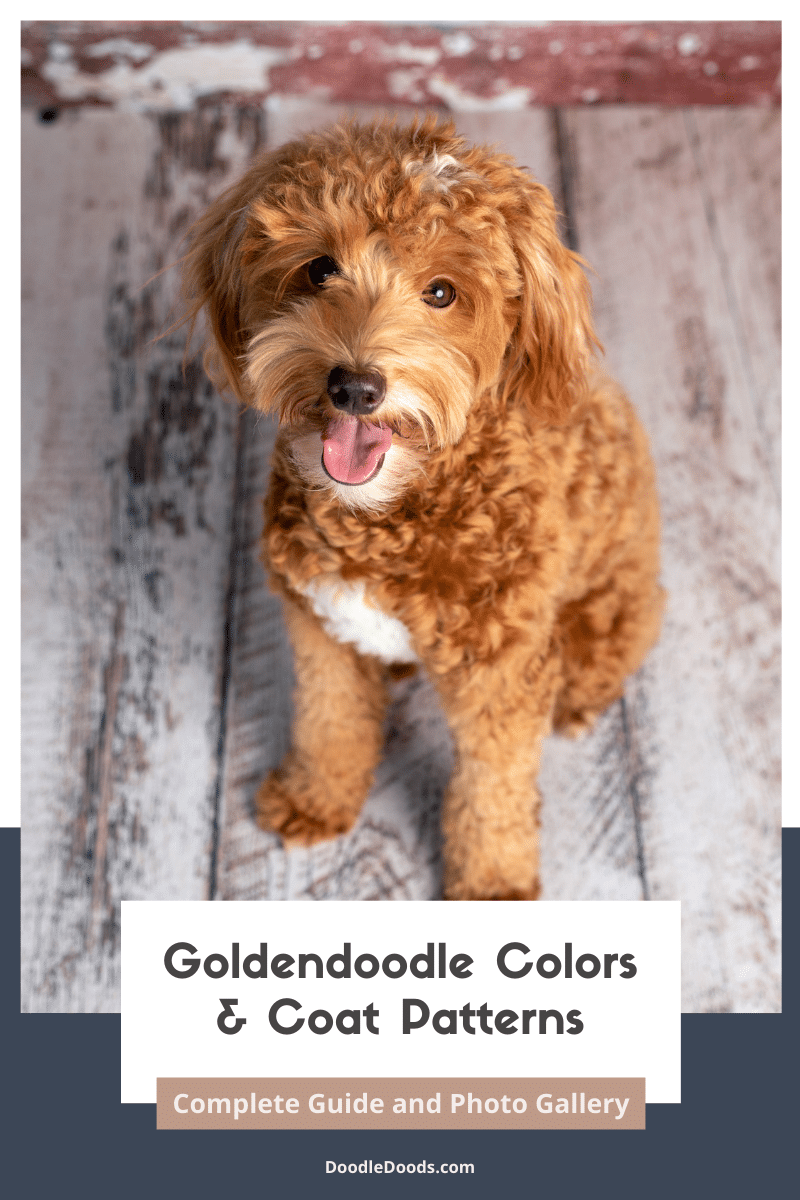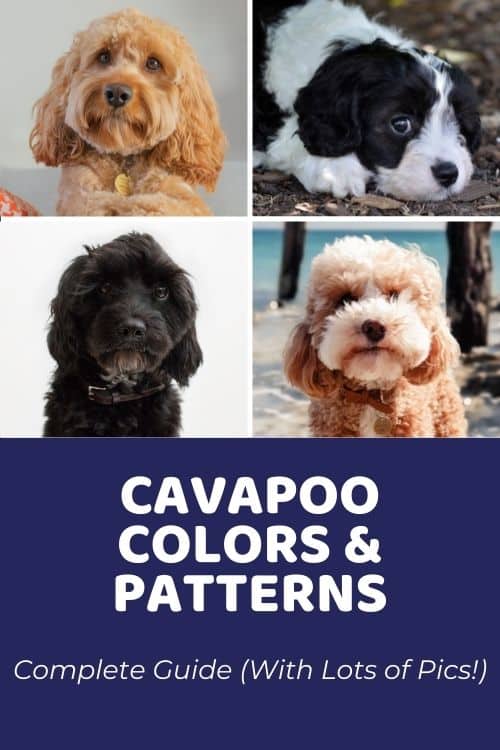If you’re planning to adopt a Labradoodle, at one point or another you’re probably wondering – which Labradoodle color should you choose? In this guide, we’ll take a look at all the different Labradoodle colors and coat patterns with tons of pics. Here we have the most popular Labradoodle colors and the rarest ones included. We’ll also be discussing if a Labradoodle will change color over time and if a Labradoodle’s color can affect their health or temperament. Let’s dive in!
Table of Contents
- Labradoodle Colors & Patterns: Introduction
- Labradoodle Colors: Their Heritage
- Labradoodle Color Chart
- Do Labradoodle Puppies Change Color?
- Does Coat Color Affect Labradoodle’s Health And Behavior?
- Labradoodle Colors: Which One Should You Get?
- Labradoodle Colors & Patterns: FAQ
- Labradoodle Colors & Patterns: Conclusion
Labradoodle Colors & Patterns: Introduction
A gorgeous hybrid mix of the Poodle and Labrador Retriever, the Labradoodle is likely the most popular Doodle breed along with the Goldendoodle. Labradoodles are intelligent, easily trainable, friendly, and affectionate pups who can melt anyone’s heart in a matter of seconds. They possess many of the same qualities as the happy-go-lucky Labrador Retriever parent and they benefit from the low-shedding genes from the Poodle’s side of the lineage.
But as the Labradoodle is a hybrid breed, there can be so many Labradoodle color variations and patterns. Which one should you choose? Is one Labradoodle color better than the other? Let’s find out.
This page is sponsored by our
Featured Labradoodle Breeders
Greensboro, NC
Salado, TX
Billings, MT
Round Rock, TX
Labradoodle Colors: Their Heritage
Inevitably, we have to take into account that as we’re combining two different purebred dogs, the outcome can be somewhat unpredictable. It might be tricky trying to predict the color of a Labradoodle pup, as this is greatly determined by their genetics. So, before we take a look at all the different Labradoodle colors and coat patterns, let’s quickly discuss a bit about the colors of their parent pups.
Labrador Retriever Colors
Labrador Retrievers usually come in all solid colors. Most common ones include yellow, black, chocolate, red, white, and silver. Some of the more rare Labrador Retriever colors are, in fact, color combinations. These include black with white markings on the chest, black and tan, or brindle.
Poodle Colors
Similarly to the Labrador Retriever, Poodles most commonly come in solid colors. The most common colors we see on Poodles are black, blue, silver, gray, white, brown, cream, apricot, silver beige, red, and cafe au lait. Additionally, some Poodles can also come in a variety of color combinations like black and brown, black and tan, black and apricot, black and cream, brown and apricot, brown and white, and many others.
Labradoodle Color Chart
Labradoodles come in all shapes and sizes, coat types, and colors. Here’s a comprehensive list of all the Labradoodle colors and color patterns that you might come across.
Golden Labradoodle a.k.a Apricot Labradoodle
Possibly the most popular and widely known Labradoodle color is the golden Labradoodle, also known as apricot Labradoodle. Apricot Labradoodles have a rich colored coat resembling the inside of a ripe apricot. Hence the name apricot Labradoodle. Apricot Labradoodles usually have a black nose and their hair color is typically the same throughout the coat.
However, apricot Labradoodles may change color over time. Some pups fade lighter as they age and some are born with a cream coat that becomes darker over time.
Red Labradoodle
The insanely gorgeous red Labradoodles are more unique and harder to find. A red Labradoodle falls in a similar tone category as an apricot Labradoodle, but they have a much richer pigment and a distinctive red hue to their coat. Similarly to apricot Labradoodles, red Labradoodles might fade over time, which often results in a tan Labradoodle.
Black Labradoodle
A black Labradoodle comes in a solid all black coat with no other colored markings. Black Labradoodles also have black noses, black paw cushions, and eyes. Black Labradoodles aren’t as rare as some other colors, as both Labrador Retrievers and Poodles can come in solid black. On the other hand, like many other Labradoodle colors, pups who have a black coat may fade lighter into a more gray-ish tone over time.
Chocolate Labradoodle a.k.a. Brown Labradoodle
The chocolate Labradoodle is a rich brown Labradoodle. They’re sometimes born almost black, but their coat color will turn into a beautiful chocolate toned coat after a while. Chocolate Labradoodles can come with either brown eyes, or much more rare blue eyes. Their nose is typically brown or has a rose-y hue. As chocolate Labradoodles are so popular, it might be harder to get your hands on one.
Cream Labradoodle a.k.a. Tan Labradoodle
Cream Labradoodles have the signature beige-colored Doodle coat. The shade can vary in darkness and sometimes even have some gold or apricot markings on the face or paws. Their nose is usually black or dark brown. As their hair darkness can vary, cream Labradoodles are also often referred to as tan Labradoodles. There’s also the caramel Labradoodle that has a similarly colored coat, but they tend to come with lighter brown noses.
Blue Labradoodle
Blue Labradoodles are one of the more rare options out there. They are usually born with a black coat and as they age, they turn into a more gray-ish, smoky blue tone. Although they’re born with a black coat, their skin actually has a blue or gray pigment. During their first year from birth, their coat will change to match their skin tone. Their nose pigment is usually blue or gray that matches the skin. Most commonly, blue Labradoodles have brown eyes, but there are also the super rare, yet super gorgeous blue Labradoodles with blue eyes.
Silver Labradoodle a.k.a. Gray Labradoodle
Silver Labradoodles are very similar to blue Labradoodles. The silver can range anywhere from very light gray to dark charcoal color. Similarly to blue Labradoodles, silver Labradoodles are usually born with a much darker coat color. As they become older, their true coat color will start to appear. Again, this Labradoodle color is more of a rarity, and you should expect to pay more for a silver Labradoodle.
Parti Labradoodle
A parti Labradoodle has two colors present in their coat, both of them taking up about 50%. For instance, a brown and white Labradoodle is considered parti, as they have a white base color with large blotches of brown throughout the coat. Of course, parti Labradoodles can also have other colors instead of brown, such as apricot, black, blue, or silver. Achieving a parti Labradoodle requires a ton of DNA testing to make sure the right genes are present. Therefore, this is again a more rare Labradoodle color.
Black and White Labradoodle a.k.a. Tuxedo Labradoodle
A tuxedo Labradoodle or black and white Labradoodle has a solid black base with white patches on the chest and neck. As you might guess, the white patches form a tuxedo-like pattern. Although there are also parti black and white Labradoodles, the tuxedo pattern is usually what people refer to. When it comes to Labradoodles, the black and white tuxedo pattern is rather difficult to achieve, making it another rare Labradoodle pattern.
Sable Labradoodle
Sable Labradoodles are usually born with a dark coat that lightens as the puppies start reaching adulthood. Once adults, sable Labradoodles have a solid base color, typically cream, apricot, or tan, with darker tips at the ends of the hair. Some pups keep the dark tips, while others outgrow them completely. However, sometimes their ears stay darker. Again, this is a more rare Labradoodle color, which might be more difficult to come across.
Merle Labradoodle
A merle Labradoodle is a super rare find, as the merle gene isn’t common in either Poodles or Labrador Retrievers. Merle Labradoodles can come in a variety of shades. Some merles have blues, grays, and silvers, while others have chocolate, red, apricot, and cream. They have a solid base color with speckled patches of diluted colors throughout the coat.
Phantom Labradoodle
Phantom Labradoodles have a dominant base color, such as black or brown with lighter markings of another color on the face, chest, legs, and paws. The phantom Labradoodle comes with a distinctive pattern, where markings are placed above the eyes and around the muzzle. Phantom Labradoodles are born with the pattern, so you’ll know very early on whether or not your puppy has the phantom pattern.
Abstract Labradoodle
Abstract Labradoodles are very similar to parti Labradoodles. But with one exception. Although both partis and abstracts usually come in a pattern of two solid shades, abstract Labradoodles have less than 50% of white. There are various color combinations possible, but the most common ones include white and brown, white and tan, or black and white Labradoodle.
Brindle Labradoodle
Brindle Labradoodles have a stripe pattern all across their body, which resembles much of a tiger. It’s usually a combination of both darker and lighter colors. The darker color is more prominent while the lighter highlighted stripes are present all throughout the coat.
Do Labradoodle Puppies Change Color?
Like many other Doodles, Labradoodles often change color or fade as they reach adulthood. Usually, Labradoodle puppies change color during their first year from birth. This is due to the fading genes inherited from the Poodle’s side of the lineage. If your puppy has inherited the fading gene, you’ll most likely notice them changing colors somewhere between 6 to 12 months of age.
The fading or clearing is usually more prevalent in darker colored Labradoodles like black, brown, or chocolate. It’s especially common in sable Labradoodles, who almost always carry the fading gene. You can typically expect a black Labradoodle to fade into silver, blue, or gray tones. Chocolate Labradoodles tend to become tan, cream, or silver as they age.
Does Coat Color Affect Labradoodle’s Health And Behavior?
Although there are many myths surrounding the topic, there’s no scientific proof that the color of a Labradoodle in any way affects their health or temperament. Behavioral problems usually stem from improper or inconsistent training. If your pup is acting up, we recommend you get in touch with a professional dog trainer or try an online puppy school. Since Labradoodles are exceptionally intelligent, you’ll notice your pup catching up on new behaviors pretty quickly.
Having said that, there is a link between certain health problems and the merle gene. Merle Labradoodles have a slightly increased risk of blindness and deafness. For this reason, ethical breeders never cross two merle Labradoodles, as this can greatly increase the chance of complications.
Labradoodle Colors: Which One Should You Get?
It all comes down to your personal preferences and which Labradoodle colors you prefer. But as we mentioned, there’s no difference between the various Labradoodle colors other than their looks. All Labradoodles have a similar temperament and each of them comes with a unique personality. They’re playful and loving companions, all of them having their own quirks.
Although you might prefer one Labradoodle color over another, we do recommend that this shouldn’t be your only deciding factor when adopting your new furry family member. In addition to that, ethical breeders place their puppies into homes based on their temperament and personality to find the best forever home for each puppy. Even though breeders will ask you about your preferences, they won’t guarantee that you’ll be able to get the exact color you wanted. After all, the most important thing is that your new companion fits your lifestyle and household.
Labradoodle Colors & Patterns: FAQ
What Color Will My Labradoodle Puppy Be When They Grow Up?
Labradoodles often carry the fading gene, which is inherited from the Poodle parent. If your puppy is carrying the fading gene, they will most likely become lighter and fade as they start nearing adulthood. Black Labradoodles usually fade into silver or blue tones, whereas chocolate Labradoodles fade into more creamy, tan, and beige tones.
If you’d like to have a better understanding of your Labradoodles actual coat color, you can always ask your breeder about their genetic makeup and the colors of the previous litters. The only way to determine whether or not your Labradoodle will change color is by DNA testing.
What Is The Rarest Labradoodle Color?
The rarest Labradoodle colors are actually different color combinations and patterns. These include the parti Labradoodle, merle Labradoodle, phantom, tuxedo, sable, abstract, and brindle. In solid Labradoodle colors, the red Labradoodle is the rarest of them all.
Labradoodle Colors & Patterns: Conclusion
With so many Labradoodle colors and patterns to choose from, making the decision can be quite difficult. There are so many beautiful solid Labradoodle colors like chocolate, cream, apricot, and black. And then there are the rarity options like sable, merle, parti, and phantom. What makes it so difficult is that they all look absolutely adorable in their own, unique way. We hope this guide has given you a great overview of all the different Labradoodle colors and coat patterns.
Learn Which Doodle Is Best For You!

Avoid making the mistake of choosing the wrong Doodle temperament for your family, lifestyle, or current living situation.
Learn More















Parents of Labradoodles: What color is your Labradoodle and did they change color as they aged? Let us know in the comments below!